어떤 상황에서 목소리를 내야 했지만 그러지 못한 적이 몇 번이나 있나요? 아니면 사람들이 당신을 함부로 대하는 것 같은 기분이 들었나요?
좋은 소식 - 단호함 훈련을 통해 자신감을 얻을 수 있습니다. 정중하게 자신의 생각을 말해보세요.
이 글에서는 개발을 위한 최고의 팁을 공유합니다. 적극적인 의사소통 능력. 자신의 주장을 전달하는 데 어려움을 겪거나 현관 매트가 되는 경향이 있든 상관없이 자기 주장은 배울 수 있는 기술입니다.

차례
자기주장적 의사소통이란 무엇입니까?
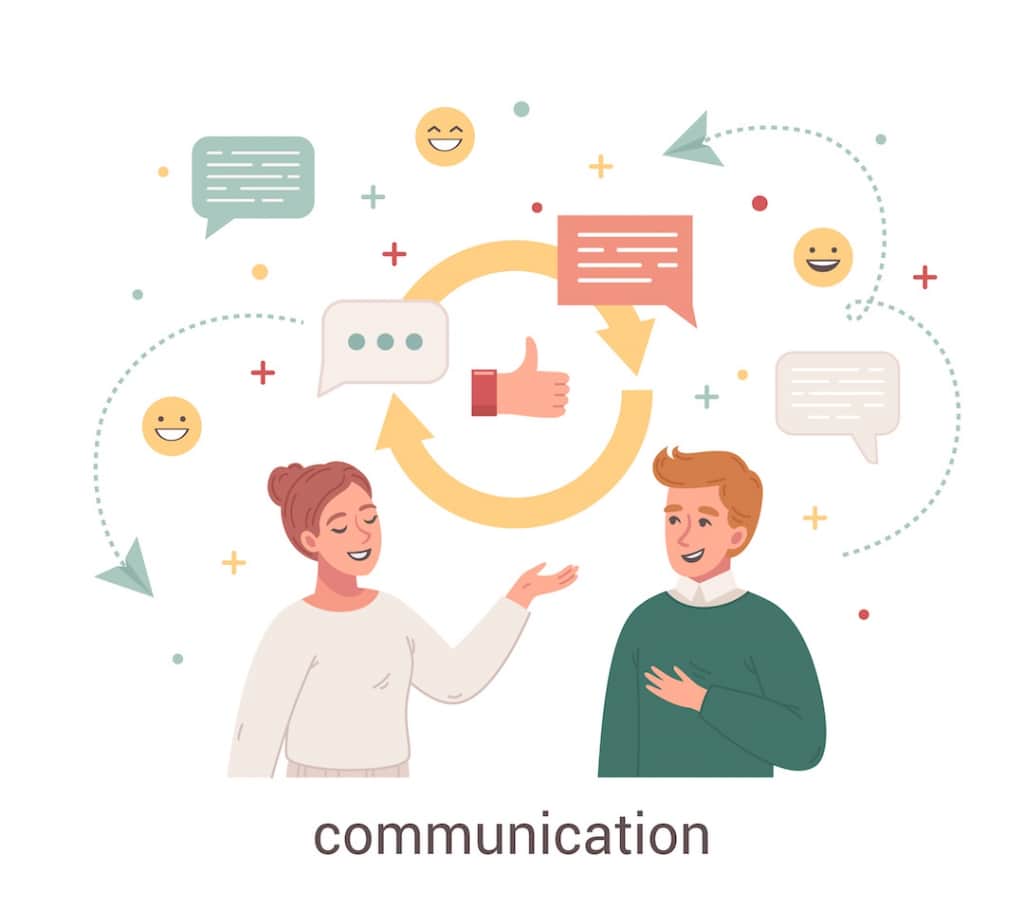
적극적인 커뮤니케이션 자신의 권리와 의견을 옹호하는 동시에 다른 사람도 존중하는 의사소통 스타일입니다.
우리 모두 이런 경험이 있을 겁니다. 마음에 들지 않는 요청이 들어왔을 때요. 그냥 포기하고 분노가 쌓이도록 내버려 둘 건가요? 아니면 맹렬하게 거절하며 핵폭탄을 터뜨릴 건가요? 더 나은 방법이 있습니다. 관계를 육성하고 실제 요구 사항을 충족시킵니다.
수동적이고 공격적인 사람들은 시간이 지남에 따라 현관 매트가 되거나 신뢰를 파괴합니다. 그리고 수동공격적인 사람들은요? 얇게 가려진 잽은 벨트 아래에 있습니다. 이러한 스타일 중 어느 것도 좋은 결과로 이어지지 않습니다.
자기 주장은 외교관의 접근 방식. 상호 이해를 찾기 위해 분쟁에서 두 가지 관점을 모두 인정합니다.
자기주장을 펼칠 때 양측 모두 자신의 의견이 존중받는다고 느끼며, 갈등보다는 협력이 우선시됩니다. 지나치게 협조적이거나 공격적인 태도는 아무런 성과도 가져오지 못합니다. 모든 측면에서 자신감 있는 중용의 지점을 찾아야 합니다. 외교는 문제를 제대로 해결하고 관계를 유지하는 데 효과적입니다.
관련 :
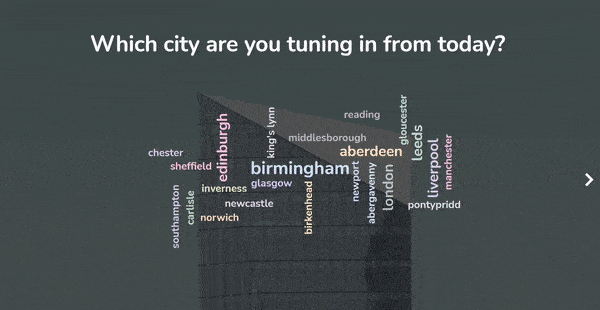
모임 중에 더 많은 재미를 찾고 계십니까?
AhaSlides에서 재미있는 퀴즈로 팀원들을 모아보세요. AhaSlides 템플릿 라이브러리에서 무료 퀴즈에 참여하려면 가입하세요!
🚀 무료 퀴즈 받기☁️
단호한 의사소통의 3C
단호한 의사소통의 3C는 통제력, 명확성, 자신감으로, 이는 다른 사람에게 횡포하거나 공격적으로 인식되지 않으면서도 단호함을 실천하는 데 도움이 되는 중요한 틀을 제공합니다.
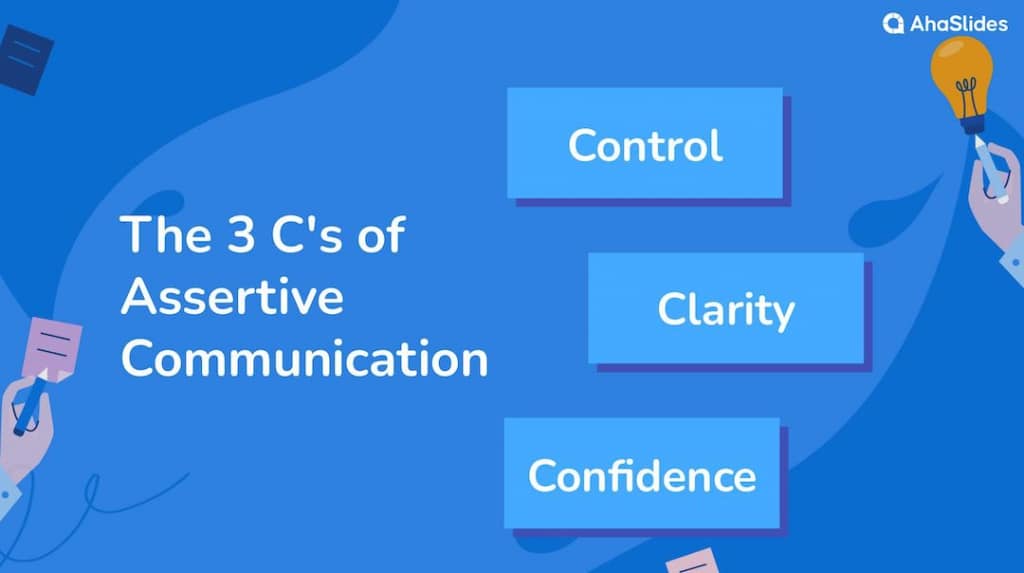
Control:
긴장된 상황에서는 당황하거나 후회할 말을 하기 쉽습니다. 하지만 연습을 통해 침착하고 차분하며 침착함을 유지하는 법을 익힐 수 있습니다. 대답하기 전에 심호흡을 하고, 판단하지 않고 적극적으로 경청하세요. 이러한 작은 습관들이 어떤 대화든 주도적으로 이끌어갈 수 있도록 도와줍니다.
선명함
많은 오해는 모호하거나 수동적 공격적인 언어에서 비롯됩니다. 직접적이고 정중하게 솔직하게 말함으로써 혼란을 해소하세요. 비난하지 않고 "나"라는 표현을 사용하여 자신의 필요와 견해를 객관적으로 표현하세요. 진실을 명확하게 말할 때 모호한 메시지는 용납할 수 없습니다.
자신감
자신을 효과적으로 주장한다는 것은 자신이 누구인지, 무엇을 할 수 있는지 당당하게 말하는 것을 의미합니다. 자신의 가치를 알고, 준비된 자세에서 우러나오는 자신감을 가지고 말하세요. 사실을 명확히 하고, 자신의 지식을 공유하는 것을 부끄러워하지 마세요. 내면의 침착함과 어울리는 바디 랭귀지와 어조를 사용하세요.
자기주장적인 의사소통 기술을 연습하기 위한 5가지 팁
각 시나리오는 고유하지만 다음 팁은 당신의 적극적인 의사소통 기술을 연마하고 고급 외교관이 되는 데 도움이 될 것입니다.
#1. "나" 문장을 사용하세요
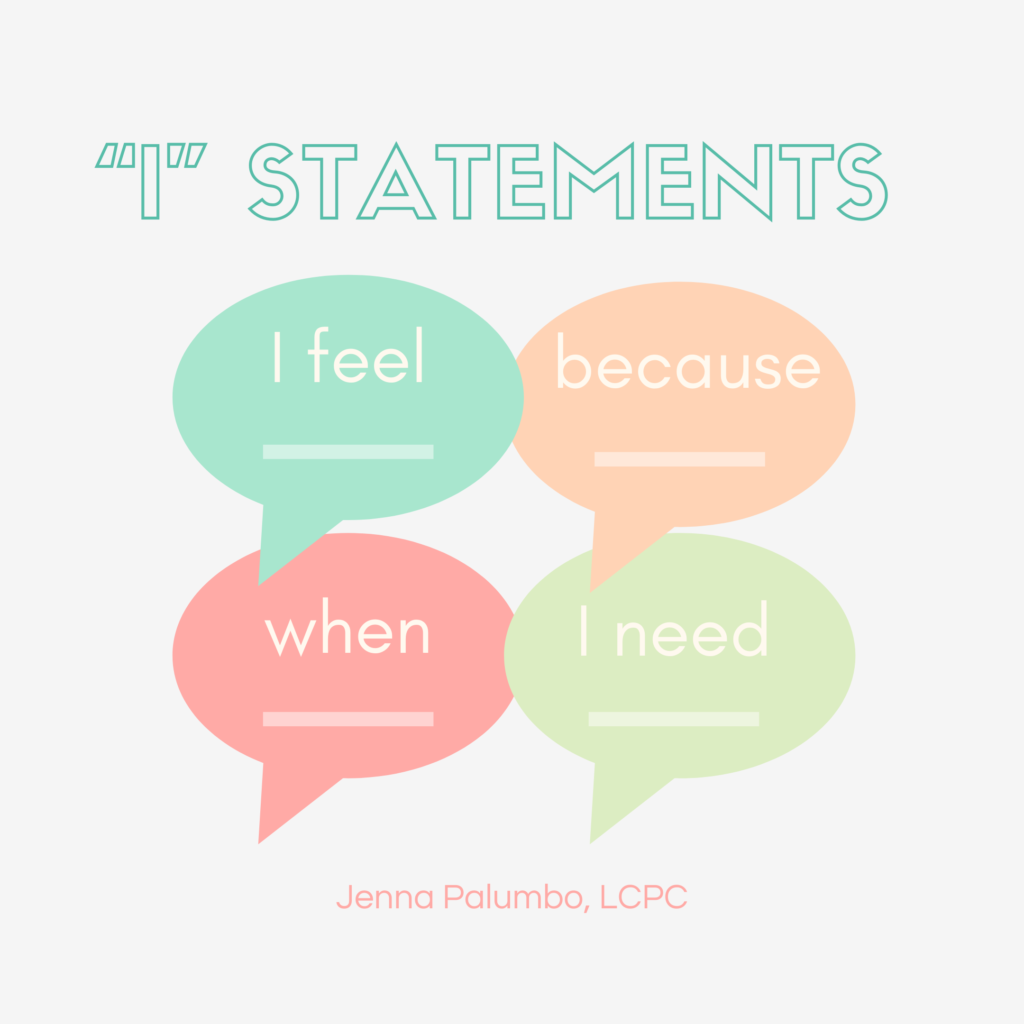
그래서 당신은 동료들과 자주 충돌하거나 회의에서 소외감을 느낀다. 아마도 당신은 무의식적으로 당신의 단어 선택에 책임을 전가하고 있을 것이다.
"네가 이렇게 해" 또는 "넌 절대 저렇게 안 해"라고 말하는 것은 "내가 누구야?"라고 말하는 것보다 더 빨리 방어적인 태도를 불러일으킵니다. 대신, "나"라는 문장을 사용하여 비난을 피하세요.
남을 공격하기보다는 자신의 관점에서 표현함으로써 단번에 온도를 낮추게 됩니다.
예를 들어, "너는 항상 늦잖아!"라고 말하기보다는, "마감일을 맞추지 못하면 짜증이 나"라고 단호하면서도 외교적으로 말해보세요.
사람들은 당신의 진심 어린 마음에 대해 반박할 수 없습니다. 그리고 비난받는다고 느끼지 않을 때 해결책을 찾는 데 더 적극적입니다. 이 간단한 "나" 표현을 사용하면 직장에서 많은 갈등을 예방할 수 있습니다.
예:
피드백을 제공할 때:
- "우리 팀 회의가 의제 항목에 집중한다면 더 생산적일 수 있다고 생각합니다."
도움을 요청할 때:
- "이 프로젝트 때문에 너무 힘들어요. 도와주실 수 있나요..."
작업을 위임할 때:
- “마감일 변경에 대해 고객에게 직접 연락해 주시면 감사하겠습니다.”
경계를 설정할 때:
- "일정 변경 시 최소 하루 전에 알려주셔야 조정이 가능합니다."
결정에 동의하지 않는 경우:
- "저는 그런 접근 방식에 동의하지 않습니다. 제 경험상..."
#2. 눈맞춤을 유지하세요

직장에서 말할 때 메시지가 전달되지 않는 듯한 느낌을 받은 적이 있습니까? 시선을 피하는 등 잘못된 의사소통 전술 때문일 수도 있습니다.
눈을 마주치거나 마주치지 않는 것은 당신의 자신감을 크게 보여줍니다. 대화 중에 눈을 마주치면, 당신이 하는 말을 믿고 자신의 견해를 고수하는 것을 두려워하지 않는다는 것을 보여줍니다.
아래를 내려다보거나 방 안을 둘러보는 데 익숙하다면 처음에는 어색하게 느껴질 수 있습니다. 하지만 대화하는 사람에게 시선을 고정하면 신뢰도가 즉시 높아집니다.
듣는 사람은 당신이 온전히 그들과 소통하고 있기 때문에 당신을 더 권위 있는 사람으로 인식합니다. 시간이 지남에 따라, 눈을 마주치며 보여주는 단호함 또한 더욱 진실하게 느껴지기 시작합니다.
그러니 앞으로 피할 수 없는 어려운 토론에 도전하세요. 다른 사람의 눈을 바라보는 용기를 내세요.
💡Tips: 전체 시선이 너무 강렬하게 느껴진다면 눈동자를 직접 바라보지 말고 눈 사이를 보세요.
#삼. 확신에 찬 어조로 자신있게 말하세요

당신의 메시지는 크고 또렷하게 전달되어야 합니다. 무릎 위에 웅얼거리는 것이 아니라요! 자신감은 하루아침에 생기지 않지만, 오늘부터 목소리 활용법에 집중하여 소통 방식을 바꿔보세요.
토론에 참여하거나 어려운 대화를 처리할 때 일정한 크기와 속도로 말하십시오. 확신에 찬 어조는 귀하가 자신의 관점을 믿고 있으며 자신의 의견을 들을 권리가 있음을 전달합니다.
신경이 곤두서면, 깊게 숨을 쉬면서 흔들리는 말을 계속하세요. 연습을 하면 권위 있는 목소리가 새로운 일상이 될 것입니다.
동료와 고객 모두 목소리 전달을 통해 자신감을 표현하는 개인에 의해 자연스럽게 동요됩니다. 그러니 편안하게 진정한 목소리를 들려주세요.
비록 익숙한 영역에서 벗어나야 하지만 그것이 미치는 영향을 직접 확인하실 수 있을 것이라고 약속드립니다. 당신의 아이디어는 진정으로 그 대담함을 누릴 가치가 있습니다. 귀하의 사려 깊은 의견이 강력한 플랫폼을 가질 자격이 있다고 믿으십시오.
#4. 단순한 문제가 아닌 해결책 제안

우리는 모두 만성적으로 불평만 하는 사람과 함께 일해 본 적이 있습니다. 해결책을 제시하지 않고 문제에만 잔소리를 하는 사람 말입니다.
나 좀 쉬게 해줘, 그렇지? 우려를 표명하는 것은 공정하지만, 기여하지 않고 단순히 붙잡기만 하는 것은 빨리 낡아지게 됩니다. 적극적인 커뮤니케이터로서 당신이 원하는 긍정적인 변화를 이끌어보세요.
문제가 발생했을 때는 단순히 문제점을 제기하는 데 그치지 마세요. 해결책도 함께 제시하여 당신이 문제 해결에 적극적인 팀 플레이어이지, 단순히 귀찮게 구는 사람이 아니라는 것을 보여주세요.
예를 들어, 마감일이 너무 촉박해서 걱정된다면, 단순히 불가능을 강조하기보다는 업무 재분배를 제안해 보세요. 공허한 비판보다는 실용적인 계획과 함께할 때 당신의 의견은 더 설득력 있게 전달될 것입니다.
불만 사항으로 양극화하기보다는 해결책을 중심으로 사람들을 모으십시오. 타협은 양측이 모두 윈윈(win-win)을 향해 노력할 때 갈등을 진정시킵니다.
비난보다는 협력을 유도하는 개방적이면서도 확신에 찬 태도를 유지하십시오. 문제와 제안을 적극적으로 하나로 묶으면 분노보다는 협력을 불러일으킬 수 있습니다. 오늘부터 비평가에서 경력 촉매자로 전환해 보세요!
직장에서 솔루션을 제안하는 방법의 예:
- 프로젝트가 자주 지연되는 경우 마감일을 계획하고 추적하는 데 도움이 되는 PMS 구현을 제안합니다.
- 회의가 자주 진행되지 않으면 쇄빙선이나 쇄빙선을 제안하세요. 대화 형 퀴즈 모든 사람의 참여를 유지하기 위해.
- 부서 간 소통이 부족한 경우 정기적인 업데이트 회의나 공유 프로젝트 문서화 시스템을 시작하는 것이 좋습니다.
- 작업 부하가 고르지 않게 분산된 것 같으면 작업 감사를 실시하여 책임이 명확하게 정의되고 공평하게 분할되는지 확인하는 것이 좋습니다.
- 예산 초과가 문제라면 조기 비용 산정과 고액 지출 승인 체크포인트를 제안한다.
- 장기 계획이 부족한 경우 정기적인 전략 계획 세션을 진행하여 목표와 우선 순위를 정합니다.
- 정책이 모호해 보이는 경우 직원 핸드북이나 정책 문서 위키를 사용하여 절차를 명확히 하는 것이 좋습니다.
#5. 다른 사람의 의견을 존중하세요
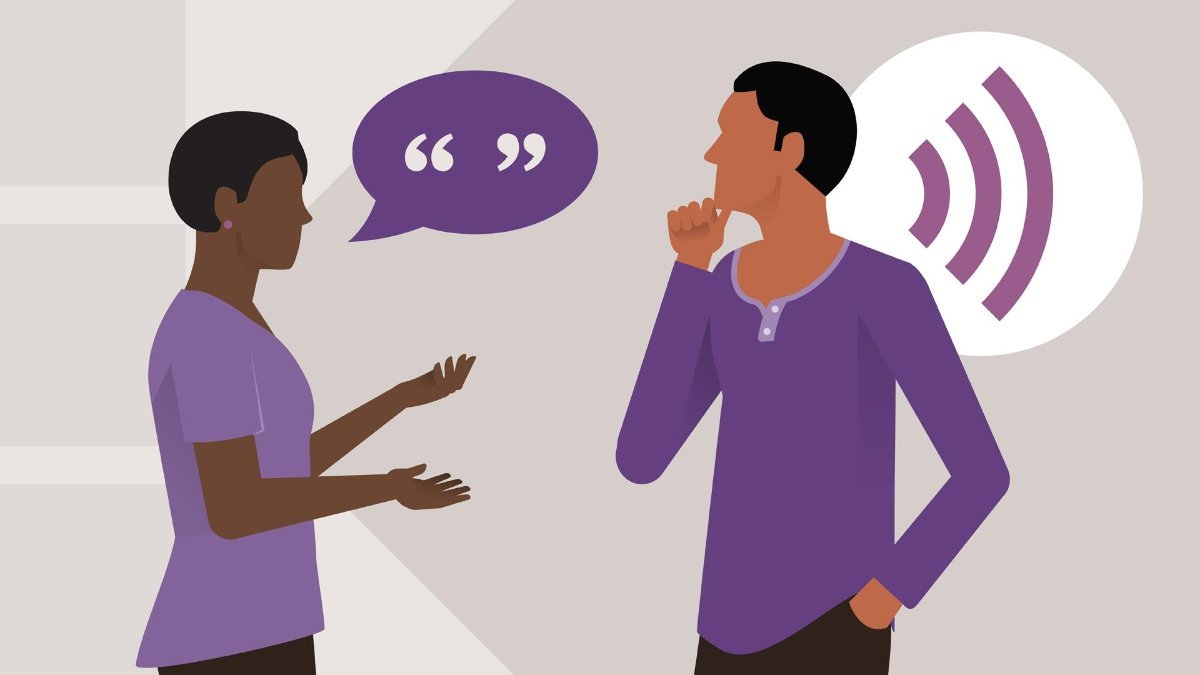
우리는 모두 상대방이 전혀 듣지 않는 일방적인 대화를 해본 적이 있습니다.
안타깝게도, 우리도 다음에 무슨 말을 할지 머릿속이 쉴 새 없이 바쁠 때 종종 그런 경험을 합니다. 하지만 단호한 소통의 달인은 적극적 경청의 기술을 완벽하게 구사합니다. 이는 차이를 넘어 진정으로 소통하는 데 핵심적인 요소입니다.
다른 사람들이 말할 때 판단을 제쳐두고 실제로 그들의 관점에서 보도록 노력하십시오. 내부적으로 반박을 하지 않고도 완전한 관점을 들어보세요.
바디 랭귀지와 어조에 주의하세요. 이 모든 것이 이해를 높여줍니다. 내면의 "사실 확인" 발언도 삼가세요.
다 마치면 발표자에게 공유해 준 것에 대해 감사를 표하세요. 감사하는 태도는 나중에 의견이 다르더라도 상대방의 관점을 존중한다는 것을 보여줍니다. 사람들은 자신의 의견이 경청되었다고 느끼고, 따라서 향후 논의에 더 적극적으로 참여하게 됩니다. 경청한다는 것은 자신의 입장을 양보하는 것을 의미하지 않습니다. 정보에 기반한 협력적인 자세로 문제를 해결하는 것을 의미합니다.
주요 요점
자기 주장을 자연스럽게 키우려면 연습이 필요하지만, 처음에는 불편함이 있어도 극복하세요. 그러면 자기 주장과 관계가 더욱 강해질 것입니다.
외교적으로 자신의 관점을 공유하는 것을 두려워하지 마세요. 그리고 다른 사람의 관점을 이해하기 위해 적극적으로 경청하는 것도 잊지 마세요.
그 결과 영향력, 생산성, 직무 만족도가 얼마나 증가하는지 놀라실 겁니다.
자주 묻는 질문들 (FAQ)
자기주장적 의사소통의 4가지 기본 구성요소는 무엇입니까?
적극적 의사소통에는 4단계가 있습니다: #1. 상황 #2. 느낌, #3. 설명, 그리고 #4. 요청.
의사소통에서 적극적인 의사소통이란 무엇인가?
적극적 의사소통은 의사소통 스타일 이는 생각, 감정, 신념을 자신감 있고 솔직하게 표현하는 동시에 다른 사람을 존중하는 것을 포함합니다.
자기 주장의 다섯 가지 장벽은 무엇입니까?
자기주장을 방해하는 다섯 가지 일반적인 장벽은 다음과 같습니다. #1. 갈등에 대한 두려움, #2. 낮은 자존감, #3. 완벽주의, #4. 경직된 사고, #5. 기술이 부족합니다.








